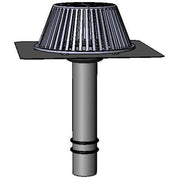Retrofit Drains
Why Do I Need Retrofit Drains?
Retrofit drains provide an essential solution for buildings experiencing drainage issues or requiring system upgrades without the need for extensive reconstruction.
These specialized components integrate seamlessly with existing roof structures and drainage systems, effectively addressing problems like standing water, inadequate drainage capacity, or deteriorating original drains. When older drainage systems begin to fail or no longer meet current building codes, retrofit drains offer a cost-effective alternative to complete system replacement. They're particularly valuable in preventing water damage to building materials, protecting structural integrity, and maintaining the effectiveness of waterproofing systems.
By installing retrofit drains, property owners can modernize their drainage capabilities while minimizing disruption to the building's current construction and daily operations.
Types of Retrofit Drains
Modern retrofit solutions come in two primary material categories, each designed to meet specific building requirements and environmental conditions.
Stainless steel retrofit offer exceptional durability and corrosion resistance, making them ideal for harsh environments or applications where long-term reliability is paramount. These units typically feature heavy-duty construction and can include drain inserts that facilitate installation without removing existing plumbing.
Alternatively, PVC- and TPO-clad options provide excellent compatibility with modern single-ply roofing systems, ensuring watertight seals and proper integration with surrounding roofing materials. These versions often include specially designed flanges that allow for direct heat-welding to the roof membrane, creating a continuous waterproof barrier.
Choosing a Retrofit Drain
Selecting the appropriate retrofit drain requires careful evaluation of several key factors.
- First, assess your existing drainage system's configuration and capacity to ensure compatibility with the new components. Consider the roofing material type, as this will influence whether a stainless steel or membrane-clad option is more appropriate.
- The drain's flow rate capacity should match or exceed your building's drainage requirements based on roof area and local rainfall intensity.
- Installation method is another crucial consideration – some systems require minimal disruption to existing plumbing, while others may need more extensive modifications.
- Finally, factor in long-term maintenance requirements and accessibility needs when making your selection to ensure the system remains effective throughout its service life.





